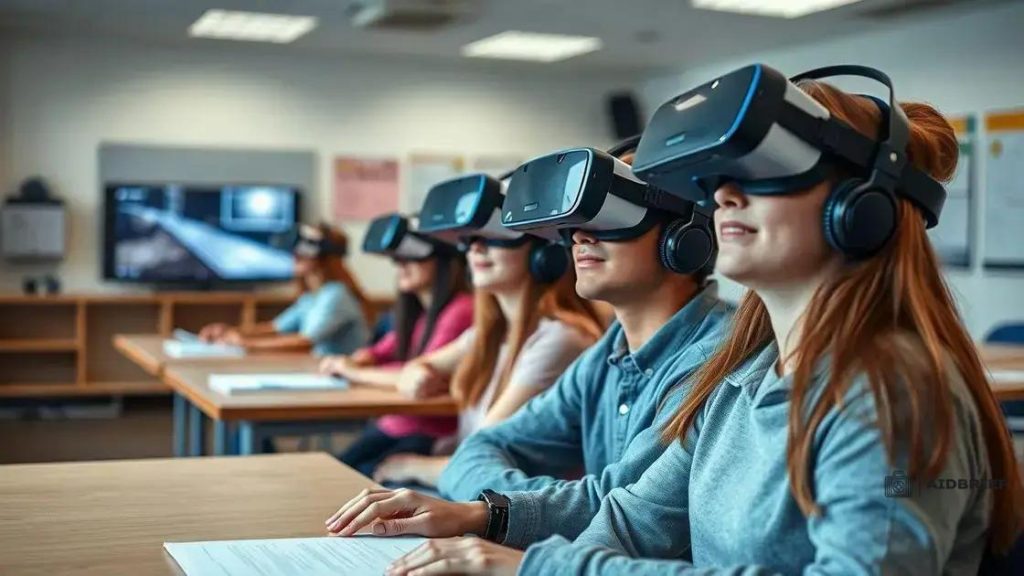Virtual reality classrooms: immersive learning experiences

Virtual reality classrooms offer immersive learning experiences that enhance engagement, personalize education, and connect students globally, transforming how subjects are taught and understood across various disciplines.
Virtual reality classrooms are reshaping how we engage with education today. Imagine stepping into a digital world where learning comes alive—sounds intriguing, right? Let’s dive into how this technology is changing the landscape of learning.
Understanding virtual reality in education
Understanding virtual reality in education is key to embracing its potential. Today, more educators explore how immersive technologies can enrich the learning experience.
What is Virtual Reality?
Virtual reality (VR) is a computer-generated simulation that provides users with an interactive, three-dimensional environment. This technology allows students to engage with content in ways that traditional classrooms cannot offer.
How Does It Work?
Through VR headsets, learners can immerse themselves in different scenarios, which helps them understand complex subjects. These simulations make it easier to grasp concepts that might be hard to visualize.
Key Benefits of VR in Education
- Enhances engagement and motivation
- Allows for experiential learning
- Fosters better retention of information
By providing a hands-on approach, students can actively participate in their learning process. For instance, a student studying marine biology can explore a coral reef without leaving the classroom.
Beyond just engagement, virtual reality helps in developing important skills. Students can practice things like public speaking or technical skills in a safe environment. This practice reduces anxiety and builds confidence.
Potential Challenges
While the benefits are clear, there are challenges to implementing VR. Not all schools have the necessary technology or infrastructure to support virtual reality programs. Moreover, teachers need training to use these tools effectively.
Even with these hurdles, the interest in VR continues to grow. As technology advances, it is becoming more accessible and easier to integrate into educational settings. This opens new opportunities for innovative teaching methods that can benefit all learners.
In conclusion, understanding virtual reality in education paves the way for a transformative approach to learning. Embracing this technology can lead to remarkable improvements in student engagement and skill development.
Benefits of immersive learning environments
The benefits of immersive learning environments are significant and can transform education. These environments allow students to engage deeply with the material, making learning both fun and impactful.
Enhanced Engagement
In a traditional classroom, students may struggle to concentrate. However, immersive learning captivates their attention. With interactive experiences, learners feel more involved and motivated to participate.
Improved Retention
Research shows that when students are actively involved in their education, they retain more information. Immersive environments help to create memorable experiences. These can be simulations of historical events, scientific experiments, or even complex mathematical problems.
Real-World Applications
- Students can practice real-world skills, such as public speaking or teamwork.
- They can explore different cultures and environments, gaining a broader perspective.
- These settings often include practical exercises that prepare students for future careers.
Furthermore, immersive learning environments encourage collaboration among students. Working together in virtual settings can boost teamwork skills. This collaboration is essential for success in modern workplaces.
Students also develop critical thinking and problem-solving abilities. As they navigate challenges in a virtual space, they learn to think creatively and adapt to new situations. This has lifelong benefits that extend beyond the classroom.
Accessibility for All Learners
Immersive learning can accommodate different learning styles and needs. Visual learners can benefit greatly from simulations that appeal to their strengths. Meanwhile, kinesthetic learners thrive in hands-on experiences, which are plentiful in immersive settings.
Finally, immersive learning environments can bridge gaps in education. They provide access to resources and experiences that might not be available in a traditional classroom. This creates equity in education, where all students can access the same high-quality learning opportunities.
Real-world applications of virtual reality classrooms

Real-world applications of virtual reality classrooms showcase how this technology can transform education across various fields. As schools and educators adopt VR, the possibilities for immersive learning expand significantly.
Science Education
In science classes, students can conduct virtual experiments that may be too dangerous or costly in real life. They can explore the human body, study chemical reactions, or even embark on a journey through space. This hands-on experience enhances their understanding and sparks their interest in science.
History and Social Studies
Virtual reality classrooms allow students to travel back in time. They can walk through ancient civilizations or witness significant historical events. This immersive learning enables them to connect with history and fosters a deeper appreciation for different cultures.
Medical Training
- Medical students can practice surgeries in a risk-free virtual environment.
- They can interact with realistic patient simulations.
- This practical experience prepares them for real-life scenarios in healthcare.
The use of VR in medical training is particularly impactful. Students gain confidence and better skills by practicing procedures in a controlled setting, improving their readiness for actual patient care.
Another exciting application is in language learning. Virtual reality classrooms can transport students into different countries where they practice conversations in real-life contexts. This method accelerates language acquisition and makes learning enjoyable.
Vocational Training
Employers are increasingly considering VR for workforce training. Industries like construction, manufacturing, and aviation benefit from trainees practicing skills on virtual equipment. This hands-on approach ensures that workers are well-prepared for their jobs, reducing accidents and boosting efficiency.
Furthermore, virtual reality classrooms can facilitate collaborative projects among students across the globe. Participants from different parts of the world can work together on simulations, promoting teamwork and global awareness.
Ultimately, the applications of virtual reality classrooms are diverse and continually evolving. From enhancing educational experiences to preparing students for future careers, VR holds immense potential in shaping the future of learning.
Challenges in implementing VR in schools
Implementing VR in schools can lead to amazing educational experiences, but it also comes with significant challenges. Understanding these hurdles is crucial for effective integration.
Cost of Technology
The cost associated with virtual reality technology can be a major barrier. Schools need to invest in VR headsets, software, and the necessary hardware to support them. These expenses can be difficult, especially for underfunded schools.
Training for Educators
Another challenge is training teachers to use VR effectively. Educators need to be comfortable with the technology and understand how to integrate it into their lesson plans. Many teachers may lack experience with VR technology and require professional development to feel confident.
Technical Issues
- Connectivity problems can disrupt VR experiences.
- Software updates and maintenance require IT support.
- Students might face difficulties navigating the technology.
Technical issues can also impede smooth implementation. Schools need reliable internet and IT support to manage any challenges that arise. If technology fails, it can frustrate both teachers and students.
Furthermore, there are concerns about student safety while using VR. Proper guidelines must be established to prevent accidents or discomfort during virtual experiences. Teachers must supervise and ensure that students use the equipment safely.
Curriculum Development
Another obstacle is aligning VR content with existing curricula. Educators must develop or find appropriate VR resources that match their educational goals. It is crucial that VR experiences are relevant to the subjects being taught, providing real value to students.
Additionally, there might be resistance from parents or administrators who are skeptical about the effectiveness of VR in education. Educating stakeholders on the benefits and potential of virtual reality classrooms can help ease these concerns.
Despite these challenges, careful planning and support can lead to successful implementation of VR in schools. Addressing issues related to cost, training, and safety will pave the way for a more immersive learning experience.
The future of education with virtual reality
The future of education with virtual reality seems bright and full of possibilities. As technology continues to evolve, VR will likely become more integrated into classrooms worldwide.
Personalized Learning Experiences
One significant advantage of using VR is the ability to create personalized learning experiences. Students can advance at their own pace, exploring topics that interest them in a more engaging way. This flexibility allows for tailored education that meets individual needs.
Global Classrooms
Virtual reality classrooms can connect students from all over the world. They can join together in immersive environments, experiencing different cultures and ideas firsthand. This global perspective promotes understanding and collaboration among diverse groups.
Interdisciplinary Learning
- Students will learn subjects in context, blending science, history, and art.
- Complex topics can be simplified through immersive simulations.
- Creative projects can thrive when technology supports multiple disciplines.
In the future, education will not be confined to traditional boundaries. Virtual reality allows for interdisciplinary approaches where students learn through immersive experiences. For example, a history lesson about ancient Egypt could incorporate art and science, giving students a holistic understanding.
Moreover, VR technology will continue to improve, making it more accessible. Devices will become lighter, more affordable, and easier to use, encouraging schools to adopt virtual reality technology faster.
Collaboration with Industry
As companies recognize the value of VR training, schools may partner with industry leaders. This connection can help students gain valuable skills that are directly applicable to future careers. For example, virtual internships can provide real-world experience without leaving the classroom.
Furthermore, educators will likely develop new teaching methods that leverage VR’s potential. This evolution will require ongoing professional development for teachers to stay up-to-date with the latest tools and techniques.
In summary, the future of education with virtual reality is promising. It offers opportunities for personalized, global, and interdisciplinary learning experiences. With ongoing advancements, students and educators may fully harness VR’s transformative power.
FAQ – Frequently Asked Questions about Virtual Reality in Education
How does virtual reality enhance student engagement?
Virtual reality creates immersive and interactive experiences that capture students’ attention, making learning more engaging and enjoyable.
Can virtual reality be used in all subjects?
Yes, virtual reality can enhance learning in various subjects such as science, history, language, and even vocational training by providing real-world applications.
What are the challenges of implementing VR in schools?
Challenges include the cost of technology, the need for teacher training, technical issues, and aligning VR content with the curriculum.
What does the future hold for virtual reality in education?
The future looks promising, with advancements in technology making VR more accessible, personalized learning experiences, and increased global connectivity among students.





